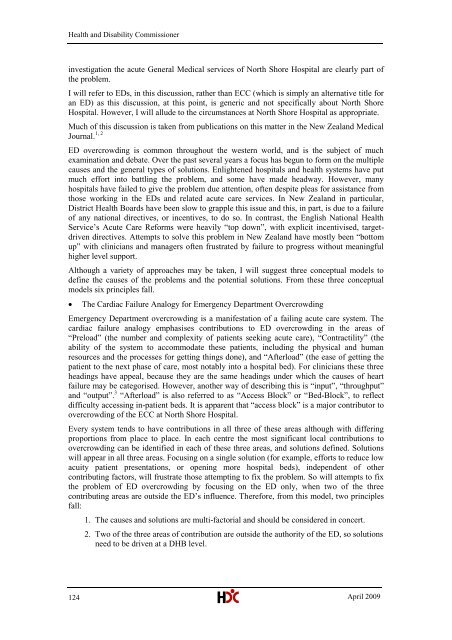North Shore Hospital report - New Zealand Doctor
North Shore Hospital report - New Zealand Doctor
North Shore Hospital report - New Zealand Doctor
You also want an ePaper? Increase the reach of your titles
YUMPU automatically turns print PDFs into web optimized ePapers that Google loves.
Health and Disability Commissionerinvestigation the acute General Medical services of <strong>North</strong> <strong>Shore</strong> <strong>Hospital</strong> are clearly part ofthe problem.I will refer to EDs, in this discussion, rather than ECC (which is simply an alternative title foran ED) as this discussion, at this point, is generic and not specifically about <strong>North</strong> <strong>Shore</strong><strong>Hospital</strong>. However, I will allude to the circumstances at <strong>North</strong> <strong>Shore</strong> <strong>Hospital</strong> as appropriate.Much of this discussion is taken from publications on this matter in the <strong>New</strong> <strong>Zealand</strong> MedicalJournal. 1, 2ED overcrowding is common throughout the western world, and is the subject of muchexamination and debate. Over the past several years a focus has begun to form on the multiplecauses and the general types of solutions. Enlightened hospitals and health systems have putmuch effort into battling the problem, and some have made headway. However, manyhospitals have failed to give the problem due attention, often despite pleas for assistance fromthose working in the EDs and related acute care services. In <strong>New</strong> <strong>Zealand</strong> in particular,District Health Boards have been slow to grapple this issue and this, in part, is due to a failureof any national directives, or incentives, to do so. In contrast, the English National HealthService‘s Acute Care Reforms were heavily ―top down‖, with explicit incentivised, targetdrivendirectives. Attempts to solve this problem in <strong>New</strong> <strong>Zealand</strong> have mostly been ―bottomup‖ with clinicians and managers often frustrated by failure to progress without meaningfulhigher level support.Although a variety of approaches may be taken, I will suggest three conceptual models todefine the causes of the problems and the potential solutions. From these three conceptualmodels six principles fall.The Cardiac Failure Analogy for Emergency Department OvercrowdingEmergency Department overcrowding is a manifestation of a failing acute care system. Thecardiac failure analogy emphasises contributions to ED overcrowding in the areas of―Preload‖ (the number and complexity of patients seeking acute care), ―Contractility‖ (theability of the system to accommodate these patients, including the physical and humanresources and the processes for getting things done), and ―Afterload‖ (the ease of getting thepatient to the next phase of care, most notably into a hospital bed). For clinicians these threeheadings have appeal, because they are the same headings under which the causes of heartfailure may be categorised. However, another way of describing this is ―input‖, ―throughput‖and ―output‖. 3 ―Afterload‖ is also referred to as ―Access Block‖ or ―Bed-Block‖, to reflectdifficulty accessing in-patient beds. It is apparent that ―access block‖ is a major contributor toovercrowding of the ECC at <strong>North</strong> <strong>Shore</strong> <strong>Hospital</strong>.Every system tends to have contributions in all three of these areas although with differingproportions from place to place. In each centre the most significant local contributions toovercrowding can be identified in each of these three areas, and solutions defined. Solutionswill appear in all three areas. Focusing on a single solution (for example, efforts to reduce lowacuity patient presentations, or opening more hospital beds), independent of othercontributing factors, will frustrate those attempting to fix the problem. So will attempts to fixthe problem of ED overcrowding by focusing on the ED only, when two of the threecontributing areas are outside the ED‘s influence. Therefore, from this model, two principlesfall:1. The causes and solutions are multi-factorial and should be considered in concert.2. Two of the three areas of contribution are outside the authority of the ED, so solutionsneed to be driven at a DHB level.124April 2009
















